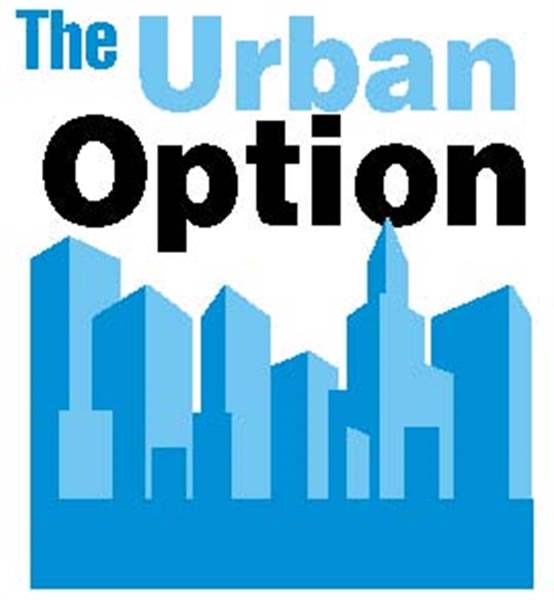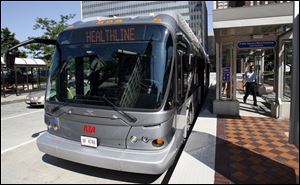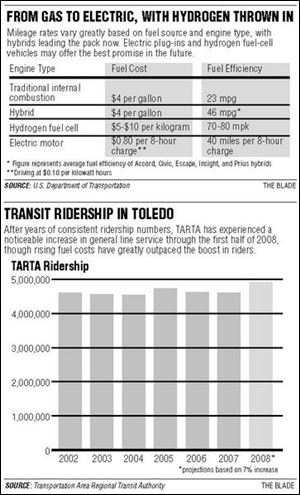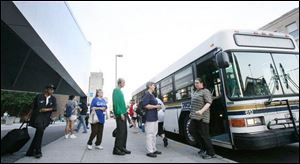
$860,000 hybrid vehicle one of Cleveland's public transit s revivals
8/12/2008
Economic conditions set the stage for the revival of cities
SUNDAY: Rising gas and energy prices have made many Americans wary of the long commutes emblematic of suburbs. Living in urban areas not only saves on gas but can offer an attractive centrality of retail and entertainment especially for an increasing number of young singles and empty-nesters.
YESTERDAY: Although urban planners say the cost of filling the family SUV will cause more people to live in city centers, some architects, builders, and home buyers are finding ways to stay in the cozy suburbs they ve grown to love, lessening environmental impacts and trimming energy bills in the process.
Today: As urban centers continue to experience a resurgence, with Americans choosing to drive less, cities across the United States are re-examining the demand for public transit from bus systems to light rail.
![]() READ: Experts believe bicycling, walking, and public transit use will rise
READ: Experts believe bicycling, walking, and public transit use will rise
![]() READ: Automakers pursuing alternative technology
READ: Automakers pursuing alternative technology
CLEVELAND Emmett Fryer maneuvers the futuristic rapid transit vehicle around a corner of Cleveland s Public Square.
The sleek 63-foot machine appears part bus and part train. It elegantly bends in the middle, its backside returning in line as it completes the turn with a pack of sidewalk onlookers watching. It moves swiftly toward Euclid Avenue, the city s main downtown thoroughfare.
The $860,000 hybrid vehicle, and 20 others like it, serve as the centerpiece of the Greater Cleveland Regional Transit Authority s new bus rapid transit project, a nearly $170 million undertaking expected to generate a hefty $4.3 billion worth of downtown economic development and demonstrate the city s commitment to public transportation.
As many of the nation s urban centers continue to experience resurgence, and as Americans choose to drive less in the face of increasing gas prices, cities across the country are re-examining how people move from place to place, gauging the demand for new forms of public transportation including light rail and rubber-wheel systems.
 SUNDAY: Rising gas and energy prices have made many Americans wary of the long commutes emblematic of suburbs. Living in urban areas not only saves on gas but can offer an attractive centrality of retail and entertainment especially for an increasing number of young singles and empty-nesters.
SUNDAY: Rising gas and energy prices have made many Americans wary of the long commutes emblematic of suburbs. Living in urban areas not only saves on gas but can offer an attractive centrality of retail and entertainment especially for an increasing number of young singles and empty-nesters.
YESTERDAY: Although urban planners say the cost of filling the family SUV will cause more people to live in city centers, some architects, builders, and home buyers are finding ways to stay in the cozy suburbs they ve grown to love, lessening environmental impacts and trimming energy bills in the process.
Today: As urban centers continue to experience a resurgence, with Americans choosing to drive less, cities across the United States are re-examining the demand for public transit from bus systems to light rail.
" rel="storyimage1" title="860-000-hybrid-vehicle-one-of-Cleveland-s-public-transit-s-revivals-2.jpg"/>
Economic conditions set the stage for the revival of cities <br> <a href=" /apps/pbcs.dll/article?AID=/20080810/NEWS16/33226367" target="_blank"><b> <font color=red>SUNDAY:</font color=red> </b> </a> Rising gas and energy prices have made many Americans wary of the long commutes emblematic of suburbs. Living in urban areas not only saves on gas but can offer an attractive centrality of retail and entertainment especially for an increasing number of young singles and empty-nesters. <br> <a href=" /apps/pbcs.dll/article?AID=/20080811/NEWS16/61341503" target="_blank"> <font color=red><b> YESTERDAY:</b></font color=red></a> Although urban planners say the cost of filling the family SUV will cause more people to live in city centers, some architects, builders, and home buyers are finding ways to stay in the cozy suburbs they ve grown to love, lessening environmental impacts and trimming energy bills in the process. <br> <b> <font color=red> Today: </font color=red> </b> As urban centers continue to experience a resurgence, with Americans choosing to drive less, cities across the United States are re-examining the demand for public transit from bus systems to light rail. <BR> <img src=http://www.toledoblade.com/assets/gif/weblink_icon.gif> <font color=red><b> READ: </b></font color=red><a href=" /apps/pbcs.dll/article?AID=/20080812/NEWS11/808120318" target="_blank"><b>Experts believe bicycling, walking, and public transit use will rise</b></a><br> <img src=http://www.toledoblade.com/assets/gif/weblink_icon.gif> <font color=red><b> READ: </b></font color=red><a href=" /apps/pbcs.dll/article?AID=/20080812/NEWS11/808120317" target="_blank"><b>Automakers pursuing alternative technology</b></a><br>
Transit systems are behind the times and inadequate, said Douglas Kelbaugh, dean of the University of Michigan school of architecture and urban planning. This country is so invested in the automobile and the road, we re not going to be able to instantly provide transit.
Cleveland s bus rapid transit line, set to launch in October along a 9.4-mile loop of retooled roadways and stations, had been discussed in various forms by community leaders for decades before the city secured federal funding in 2004.
Joe Marinucci, president of the Downtown Cleveland Alliance, said the city struggled with deciding which technology would best connect the city s two business districts downtown and University Circle, home to Case Western University and the Cleveland Museum of Art.
We were the guinea pigs in some ways for a major urban center to consider something like this, he said. We were really able to put some definition to the project and push it forward.
While bus rapid transit has recently sneaked onto the American radar, for many years the system has operated in other parts of the world, including Curitiba, Brazil, which was a model for the Cleveland project.
A rail-like approach
Bus rapid transit retains rubber tires but sheds the more cumbersome aspects of traditional bus travel. The specialized vehicles have eliminated steps and widened doors for easy platform loading.

Greater Cleveland Regional Transit Authority s new bus is considered part train.
Fare collection is prior to boarding and load times are reduced. The buses run on dedicated lanes.
Cleveland transit officials expect to cut commute time by more than 20 percent along the Euclid Avenue corridor once the bus rapid transit system supersedes the current No. 6 buses that service the system s most popular line used by just over 10,000 riders a day.
Transit officials project that 22,000 riders every weekday will use the new bus rapid transit version of the No. 6.
The silvery rapid transit vehicle in Cleveland, tattooed with logos of the Cleveland Clinic and University Hospitals, stretches 23 feet longer than a traditional bus and features rear wheels partially covered by the vehicle s frame.
It runs on an electric motor powered by ultra-low-sulfur diesel that in the future may be enhanced with hydrogen. A small electronic display inside flashes the next stop in bright red accompanied by a similar reminder from the driver over an intercom.

Our system has almost every attribute of rail except rail, said Joe Calabrese, chief executive of the Cleveland transit authority. If you operate a system that is perceived to be simple to use, has great frequency, is safe, and is clean, you will attract new riders. I am confident we will attract new riders.
Local possibilities
Mr. Calabrese, who credits former Cleveland Mayor George Voinovich for championing the project as mayor, governor, and now U.S. senator, said the scalability of bus rapid transit makes it a viable option for cities the size of Toledo. He calls the system BRT Light when cities pick and choose the elements that gel best with their existing infrastructure.
Toledo and other similarly populated cities could take advantage of the Federal Transit Administration s recently overhauled Small Starts and Very Small Starts programs, which offer up to $75 million in funding for small bus, rail, or ferry projects.
James Gee, general manager of the Toledo Area Regional Transportation Authority, which operates more than 40 bus routes a day in the city and most of its suburbs, agreed bus rapid transit could work in northwest Ohio.
Even if we start small and build a smaller line here in Toledo, we could see the resulting increases in private development, he said. It does take a leap of faith, but as other cities have demonstrated if you do take that leap with public dollars, private dollars will follow.

Jennifer Lintz of Toledo exits a TARTA bus at Erie and Madison Avenue before transferring to another bus on her way home from her night-shift job at Kroger Co. She rides the bus daily.
Bus rapid transit proponents argue a well-established line and permanent transit stations will instill confidence in real estate investors.
The spending along Euclid Avenue in Cleveland between Public Square and University Circle a street Mark Twain once called the most beautiful in America includes private development in restaurants and condominiums, educational institutions, and health facilities.
Advertisements throughout Cleveland s downtown promulgate the coming bus rapid transit line employing the slogan, pumping new life into Cleveland, an unintentional verb choice eliciting thoughts of gas pump pains that are driving many back to public transit.
Along for the ride
While bus ridership in both Toledo and Cleveland has grown in recent months, diesel costs have ballooned. And those fuel bills threaten the revenue and viability of busing systems across the country.
Many systems around the state, instead of adding service when demand is at an all-time high, are probably going to be cutting service, Mr. Calabrese said.
My diesel bill went from $5 million in 2003, to $12 million last year, to $21 million this year, and it should be about $24 million next year.
In Toledo, TARTA will cut its bus service by 7 percent on Aug. 24, a decision that has caused outcries from local riders.
Aside from rising fuel prices affecting expansion possibilities, Neil Reid, director of the University of Toledo Urban Affairs Center, warned transit officials to consider the American comfort level with buses.
Most people in Toledo, people say under 50, probably have never ridden a bus before or only on sporadic occasion, he said. People probably just don t consider that an option.
The issues may cut deeper than simple unfamiliarity.
Busing systems in many cities have been painted as ferries for the poor.
Alan Plattus, director of the Yale Urban Design Center in New Haven, Conn., said dismantling a classist attitude as has been done in many European countries may be as important to the success of buses in America as the routes they follow.
The bus system has gotten to be a class system, he said. Middle class people who might use the bus instead of taking a car trip don t do it.
For many urban planners, busing systems also have become the figurative poor man s light rail, a shot below the mark for cities focusing on asphalt instead of track and relying on tenuous data promising real estate development around buses.
John Norquist, president of the Congress for the New Urbanism in Chicago, agreed developers are more likely to be attracted to areas along rail stations or lines where the city has signaled its intention to make large, nearly indelible investments.
Light rail is good because it s permanent, he said. People say with buses they re good because they re flexible, but they could disappear at any moment.
Light rail the term applied to streetcar systems such as trolleys is nothing new.
The Richmond Union Passenger Railway came online as the first large electric street railway system in 1888, displacing horse drawn buggies.
Many cities, including Toledo, decommissioned their streetcar systems in the 1950s as the country began its migration to the suburbs and the automobile industry flourished.
Finding the right path
James Seney, former executive director of the Ohio Rail Development Commission, said old streetcar lines in Toledo fit the layout of the community and may be a guide for rail revampment.
What makes urban rail work is when you create transit routes that have clusters of neighborhoods on them, said Mr. Seney, the former mayor of Sylvania. You should design [routes] based on your existing neighborhoods and tie that into the growth of downtown businesses, rather than trying to capture a larger area.
Though Mr. Seney said new tracks would be needed if Toledo decided to move forward with a rail plan, he admitted the old guys logistically were correct.
The push toward rail is being seen in other U.S. cities.
About 100 years after its invention, light rail experienced a heavy resurgence. Most of the United States busiest light rail systems today were built or intensely renovated in the last two decades, including lines in Los Angeles; Portland, Ore.; St. Louis; Denver, and Dallas.
Even smaller cities such as Little Rock, Tacoma, and Galveston, Texas, have invested in light rail systems since the turn of the century.
The Massachusetts Bay Transportation Authority in Boston shuttles over a quarter million people per day on its green and red lines, making it by far the largest light-rail operation in the country.
Falling behind
Despite these steps toward greater public transit, some urban planners remain incensed that American cities have been lapped by international cities.
On Spain s southern border, the city of Malaga recently began construction on the Malaga Metro, a below ground transit system that covers more than 20 miles.
The undertaking more expensive and laborious than even light rail comes from a city with a population only twice as large as Toledo s.
Mr. Calabrese acknowledged Cleveland could have been well served by a light-rail system bringing additional speed, carrying capacity, and pollution abatement to the city, but that the project would have been too expensive.
The projects are getting more and more difficult to get funded, he said. [Rail] is very expensive to build and very expensive to maintain.
The transportation veteran said rail can cost as much as $100 million per mile.
The Sound Transit s Central Link light rail line in Seattle, which will connect Seattle-Tacoma International Airport to the downtown, is expected to open in late 2009 at a cost of $150 million or more per mile because of extensive tunneling and elevated structures in the West Coast terrain.
In Columbus, costs have smothered attempts by Mayor Michael Coleman to engineer an electric streetcar running on a 2.8-mile stretch between the Ohio State University campus and downtown.
The $103 million price met resistance from members of Columbus City Council, who wanted to gather more community input, though the council allotted $300,000 on July 29 to continue studying the system.
Destination points
Cleveland has North America s oldest rapid transit service to an international airport: the Red Line train service, started in 1968. But like light rail, it faces a major obstacle: population density in the city.
Mr. Reid of the University of Toledo Urban Affairs Center said efficient public transit is a product of high-density points.
Lots of people have to want to go from A to B and B to C, he said. In Toledo, we quite simply don t have those destination points.
Cities may not have to immediately pit bus rapid transit against rail. Some experts have suggested cities start with buses and follow ridership trends.
Bus rapid transit lines can be designated and more buses can be tacked on if the service starts to grow. If the volume grows to a point, then some of these vehicles can be linked together. And then tracks can be laid.
Suddenly a bus system has become a fully fledged light rail system.
Cleveland s Mr. Calabrese said he believes volume and density affect the viability of train lines between cities as well.
If you look at the intercity rail that has been the most successful, it s the northeast corridor. One reason is you have a lot of people, a lot of density, he said. We don t have the density to make rail be cost effective.
Intercity rail
While the future of rail travel within many cities remains hazy, the future of rail from city to city could be brighter.
Mr. Gee of TARTA said Toledoans could someday see train lines running from Chicago to Cleveland and Detroit to Columbus, both of which would intersect in Toledo.
It would be much easier and more convenient to take a train to Columbus than driving a personal vehicle, he said.
Mr. Gee explained that a train could provide a happy medium between long-distance flights and short-distance drives.
Others hold the belief that more local train lines to Bowling Green, Ann Arbor, or the Detroit Metropolitan Wayne County Airport might someday best serve Toledo.
The city s potential as a crossroads between bigger brothers in the region would be a return to transportation prominence it once enjoyed.
Ted Ligibel, a professor of historic preservation at Eastern Michigan University in Ypsilanti, Mich., and a prominent Toledo historian, said rail and river were once Toledo s bread and butter.
The [Maumee] river was the I-75 of its day because that connected the Great Lakes with the rest of the country he said. It was always a place of high commerce.
Mr . Ligibel said rail followed hot on the heels of Toledo s well-established water transport and soon trucking muscled in.
Toledo s location has always served its well, he said. It has always been a transportation hub.
Contact Matthew Eisen at:meisen@theblade.comor 419-724-6077.